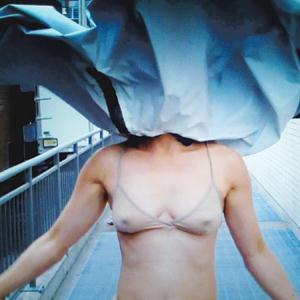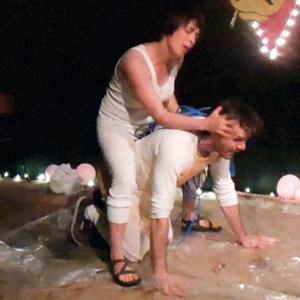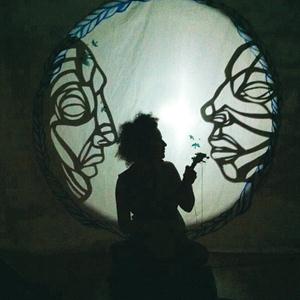
Sook-Yin Lee stars in How Can I Forget?

Jordan Tannahill and William Christopher Ellis perform Vigil(ance) as part of the Mobile Works series. Credit: Brian Wilson

Buddies' Young Creators Unit member Katie Sly performs Evil Love Songs. Credit: Brian Wilson

Coral Maloney and Ian Mozdzen perform in WEproteSTern. Credit: Brian Wilson
There’s no question that the Rhubarb Festival is one of the essential performing arts festivals in Toronto. Veteran audience members know to expect the unexpected at Rhubarb, a critic-free zone where experimentation reigns, “failure” isn’t a dirty word, and there’s a high chance you could see the best, worst and weirdest performances of your life all in the span of 90 minutes and under the same roof.
The majority of pieces are only 30 minutes long, meaning you can take a tasting-menu approach to the evening and consume your art in tapas-sized bites. Of course, with completely different week-one and week-two programming, a slew of special presentations, late-night cabarets, intimate One-to-One performances at The 519, off-site Mobile Works pieces, new works from the Young Creators Unit, not to mention the afterparties, there’s a lot to pick through in the Rhubarb program guide.
That’s where Xtra comes in. We’ve compiled a list of our top 10 don’t-miss Rhubarb events that we guarantee will make for several interesting trips to the festival, so long as you’re willing to hope for the best, forgive the worst and gleefully celebrate the weird.
Dance shows (weeks one & two)
Increasingly, Rhubarb has become a place to see some of the city’s most exciting contemporary dance, and this year’s edition has some particularly intriguing offerings. There’s All the Ladies (week one), in which Sasha Kleinplatz choreographs a female fight club; Ill Nana DiverseCity Dance Company’s new piece Fire (week one); and Dandy Decay (week two), a solo performance by George Stamos that tackles the history of queer family and inheritance from the AIDS activism of the 1980s through to the present.
The Day You Died and the Hour You Were Born (week two)
Artist-to-watch Brescia Brixia Bloodbeard is an experimental musician, stop-motion animator, shadow puppeteer and, as of recently, midwife-in-training. “I spend a lot of time delving into birth,” Bloodbeard says, “and consequently birth/death.” Which probably has something to do with the piece she’ll be performing at Rhubarb. “Acceptance of mortality is a major life task. Death is inevitable, mysterious and unpredictable. What we’re getting into here is the Mystery, with a capital M, extrapolating on that.” Fittingly, her project puts these ideas under the microscope by combining music with the incredibly delicate, beautiful and painstaking art of shadow puppetry. “I am all about this unique medium,” she says. “This past year, I’ve gone deeper into my relationship with shadow puppetry and have been performing shadow-puppet illustrated shows on the regular. Technically, I’ve been experimenting with shadows since 2008, after befriending the Mind of a Snail folks, a rad, queer shadow-puppet duo on the West Coast).” Bloodbeard is fascinated by the way her puppets — which she creates herself using paper and an X-Acto knife — lure in audiences. “In a dark room with a glowing screen, the opportunity is created for the audience to become entranced and attentive in a kind of mystical, kidlike way.”
Disco Hospital (week one)
If your chakras are feeling a little out of whack, you might want to try a trip to the Disco Hospital, a One-to-One performance by Andrew Zealley taking place at The 519. In the piece, Zealley experiments with a “new queer shamanism” by combining therapeutic touch with sonic therapy. “The project is a branch of my MFA thesis research at OCAD University, where I am investigating sound and non-Western healing practices via ritual sessions in my school studio on new- and full-moon phases.” During the intimate performance, a single audience member acts as a client of the Disco Hospital. “During the ritual that precedes each session, the client and I identify together what is going to be addressed through touch and sound.” Clients are also invited to bring an offering to exchange for the experience. “Exchange is the device used by most indigenous shamans in trade for service,” Zealley explains. “Offerings that are practical to my project are appropriate and welcome — like ear candles, tea lights, incense coals . . . I’m also partial to entheogens, amber and pearls.”
Fay Slift and the Three Bears (week one)
What happens when Goldilocks is a bit of a bear herself? “This is a naughty, campy and vulgar version of the classic tale,” explains John Paul Kane (aka Fay Slift, Toronto’s most impressively bearded drag glamour-puss), “so, it actually is more like the way it was meant to be told.” Fairy tales are obviously a hot commodity right now — it seems like every week a new film adaptation of Red Riding Hood, Snow White or Hansel and Gretel winds up at the multiplex — so is it any surprise Goldilocks has found her way to the Rhubarb Festival? For Kane, Goldi represents unrestrained id as she acts out the things we all long to do. “She has little self-control and must feed her insatiable urges, which range from petty crimes to full-on break-and-enter.” The Three Bears in this version are played by Trixie and Beever and Kaleb Robertson. But just what happens when they discover their unwanted houseguest? You decide. “It’s not a full choose-your-own adventure, just a choose-your-own ending,” Robertson says. “The main story will be the same, but the ending will have three possible choices.” Apparently, a paddle is involved. But will it be too big, too small or just right?
Evil Love Songs (week one)
Evil Love Songs, by Buddies’ Young Creators Unit member Katie Sly, has some questions to ask about the different ways promiscuity is seen in straight and gay culture. “I think straight people are having just as much sex with just as many people but might be more likely to cheat than say to a partner, ‘I want to explore polyamory,” Sly says. “Because they’re still operating under the assumption that they’re the ‘norm’ and that the norm is you fall in love with one person of the opposite gender forever.” Of course, many people use the opportunity of coming out not only to clarify which gender(s) they are attracted to, but also to expose other aspects of their sexuality that fall outside the traditional narrative. “From what I have seen and how I conduct myself,” Sly says, “the queer community is more open and honest about wanting, because we’ve had to learn not to judge our desire.” The main character of her solo piece finds herself navigating the dichotomies of straight/gay and of monogamy/promiscuity. “The piece also looks at the downtown Toronto night scene through an epic and magical lens,” Sly promises. “It gets pretty imaginative and uses fantastic beasts to allegorically express the emotional truth of certain experiences.” Lions and tigers and bears? Oh, my! “There are a few trans humans in it, or that’s how I like to think of them, though some might call them monsters.”
How Can I Forget? (week one)
This much-buzzed show is the first piece of theatre created by Sook-Yin Lee since she was 14. The DNTO host, Shortbus star and quintessential ’90s MuchMusic VJ worked on her multidisciplinary show in collaboration with dancer/choreographer Benjamin Kamino to create a mix of dance, film, music, photography and text.
The late-night cabarets (weeks one & two)
On Thursday nights at Rhubarb, things get political as special one-off late-night cabarets take over Tallulah’s. In week one, it’s Dirty Plötz, in which Jess Dobkin, Christine Pountney, Keisha Scott, Laura Kane, Hoa Nguyen and Zoe Whittall take on the role of women in art and social-justice movements. For week two, Resistance & Raunch explores slut-shaming and sexual violence as seen by Kim Crosby, Vivek Shraya and Mikiki.
Naked Page (week one)
In Naked Page, creator/performer Nicki Ward marries poetry and Japanese rope bondage, two disciplines (no pun intended) one might not expect to see united. But for Ward, the pairing makes perfect sense. “The poetic form used is ancient, rigid and mathematically disciplined,” she explains. “This is a perfect complement to the process of bondage that constrains the subject while elevating it.” During the performance, the bondage bottom is transformed into a blank page on which a sestina (a 39-line poetic form popularized by French troubadours) is written. It should definitely challenge the expectations of anyone who thought poetry is boring. “A few years ago, while I was examining my own artistic direction, I created a piece called Is Your Poetry Dangerous?” Ward says. “Could you get arrested for performing it? Does it create disturbed emotions in others? Does it change people’s minds? Does it challenge the artist, the audience and the society of others? Naked Page is dangerous in the best sense of the word.”
Vigil(ance) (week two)
Vigil(ance), a “performance intervention” created by Jordan Tannahill and William Christopher Ellis that’s part of Rhubarb’s Mobile Works series, can be summed up in a simple question: where in Toronto don’t you feel safe at night? “The germ of the idea for Vigil(ance) came a few months back while I was biking past Ossington and Dundas,” Tannahill says. “I was suddenly reminded of two separate incidents in which I had been heckled at that corner: once when a car full of young men jeered me while driving past, another time being called a faggot by an agitated elderly man as my partner, William, and I walked past.” Even in a city as progressive and cosmopolitan as Toronto, street harassment (and worse) still happens, and it can be incredibly disempowering. “When I pass Ossington and Dundas, I do not feel unsafe, but I do feel as if this intersection has been taken from me.” Audience members will meet at Videofag, the performance space Tannahill and Ellis run together, and walk through the city, visiting spaces they collectively identify as making them feel unsafe or unwelcome, where they will hold one-minute vigils. “We see Vigil(ance) as an invitation for discourse,” Tannahill says. “An activist act of reclamation and a gesture of public healing.”
WEproteSTern (week one)
Everyone’s seen the sexy cowboy routine, but has everyone thought about what it means? Coral Maloney and Ian Mozdzen, creators and performers of WEproteSTern, have. After being asked to perform at a Winnipeg edition of local queer country night Steers & Queers, Maloney and Mozdzen found themselves in a bit of a quandary. “After looking at various forms of country-and-western-themed material and drawing on our own experiences, we found it impossible to celebrate country-western style in our performance because doing so would mean accepting the erasure of a significant part of the ‘Western’ story,” Maloney explains. The Rhubarb edition of WEproteSTern expands on what Maloney and Mozdzen began exploring at Steers & Queers and attempts a thorough examination of the political responsibility of camp and fetishization. “This experience led to lots of questions,” Maloney says. “About what is queer, what is Western, what is entertainment, what is fun and what is art? Can these things coexist? And if we call something ‘queer,’ does that give us licence to ignore the problematic?”

 Why you can trust Xtra
Why you can trust Xtra


